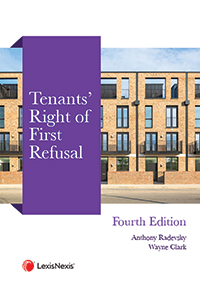
Authors: Anthony Radevsky and Wayne Clark, Falcon Chambers
Publisher: Jordan Publishing
ISBN: 9781784734763
Price: £159.99
For me, thinking about Part 1 of the Landlord and Tenant Act 1987 brings to mind the Black Knight sketch from Monty Python. You will recall that, despite losing all his limbs in a sword fight with King Arthur, the Black Knight steadfastly refuses ever to give up. Likewise, Part 1. Despite a steady loss of limbs at the hands of senior members of the judiciary—‘an ill-drafted, complicated and confused Act’ said Sir Nicholas Browne-Wilkinson; ‘the legal profession would appear to be the main beneficiaries of this obscure statute’, said Sir Thomas Bingham MR; ‘Part 1 of the Act is not worth the paper it is written on’ according to Staughton LJ—the Act refuses to lie down. It continues to challenge freeholders, leaseholders and lawyers alike.
Moving with the times
With a critique like that, there is clearly a need for a book that not only forensically examines this difficult statute, but does so in a way that is readable, informative and practical. For those of us who have to advise on this tortuous piece of legislation, I am glad to say that need is fully met by Tenants’ Right of First Refusal. Written by Anthony Radevsky and Wayne Clark, both eminent members of Falcon Chambers with 82 years’ call between them, it is the authoritative guide to this subject. Now in its fourth edition, the book still maintains the format of the first edition published some 20 years ago. There is a great deal to be said for doing that. For those of us who like to hoard earlier editions, it enables you to see how the law and indeed the views and thoughts of the authors have developed as case law battles to make sense of a statute that at times seems almost beyond rational construction.
Since publication of the third edition in 2017, there have, perhaps surprisingly, been a number of important cases, not only on the 1987 Act specifically, but also on parts of related Acts where similar provisions appear. Certainly, there has been enough to justify a new edition. Prominent in the first category are Mahmut and another v Jones and others [2017] EWCA Civ 2362 and York House (Chelsea) Ltd v Thompson [2019] EWHC 2203 (Ch), both of which are discussed at length; those falling within the second include Aldford House Freehold Ltd v Grosvenor (Mayfair) Estate and another [2019] EWCA Civ 1848, Q Studios (Stoke) RTM Co Ltd v Premier Grounds Rents No.6 Ltd and another [2020] UKUT 197 (LC) (what constitutes a ‘flat’?), and LM Homes Ltd and others v Queen Court Freehold Company Ltd [2020] EWCA Civ 371 (what are ‘common parts’?).
For those of you already familiar with the book, you will know the layout. However, for newcomers, it is worth summarising.
- Chapter 1 sets out a history of the legislation; a helpful scene-setter for what is to come.
- Chapter 2 looks at what buildings qualify, who is a landlord, and who are the ‘qualifying tenants’.
- Chapter 3 discusses the fundamental issue of what constitutes a ‘relevant disposal’.
- Chapters 4 and 5 cover the offer notice applicable to a relevant disposal and subsequent acceptance and nomination.
- Chapter 6 explains the intricacies of information notices.
- Chapter 7 discusses what rights are available where there has been a relevant disposal but the landlord has failed to follow the statutory procedure.
- Chapter 8 looks at the rights available where there is a subsequent purchaser following a non-compliant disposal.
- Chapter 9 covers notices of termination.
- Chapter 10 discusses avoidance and enforcement.
- Chapter 11 sets out the roles of the tribunals and courts.
- Chapter 12 looks at the provisions which give protection to potential purchasers.
These chapters follow an entirely logical sequence.The first of the appendices contains a very useful set of precedent forms of notice. Appendix 2 sets out the statutory material. It covers, not only ss 1-20 of the Act, both in current form and (as regards ss 5-17) as they were before the substantial amendments made by the Housing Act 1996, but also the relevant regulations, rules and practice directions for the tribunals.
Real-world issues
One criticism that is sometimes made about textbooks written by members of the Bar is that they can concentrate too much on academic analysis while overlooking practical guidance on the day-to-day issues that arise for practitioners. However, that is not a criticism that can be made here. Furthermore, the authors do not shy away from tackling some difficult issues. The inadequate drafting of the statute gives rise to several examples of ‘the law of unintended consequences’—real and potential.
One such is the question of whether disposal of only a shop below residential premises forming part of a building, amounts to a ‘relevant disposal’. As the authors point out, it is unlikely that Parliament would have intended it to be so. However, there has still been no case dealing explicitly with the point. The authors tackle the issue with gusto, fully setting out the opposing arguments clearly and concisely. It is an excellent indication of their whole approach to the subject.
There have been many calls for Part 1 of the 1987 Act to be repealed. It is said that the extended rights that now apply to leasehold enfranchisement mean that, to a large extent, it is redundant. However, despite these calls, far from repealing it, the government seems more inclined to extend the Act’s reach by bringing leasehold houses within its ambit. It appears likely therefore that the ‘Black Knight’ will continue to challenge all-comers for some time yet. With that threat, no property practitioner can afford to be without this excellent book; the statute may not be worth the paper it is written on, but this book most certainly is.
Reviewer: Damian Greenish, solicitor & senior consultant to Forsters LLP (www.forsters.co.uk).












